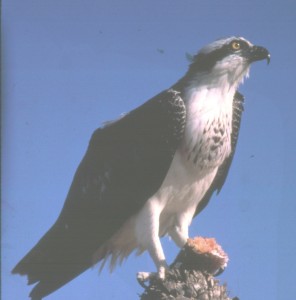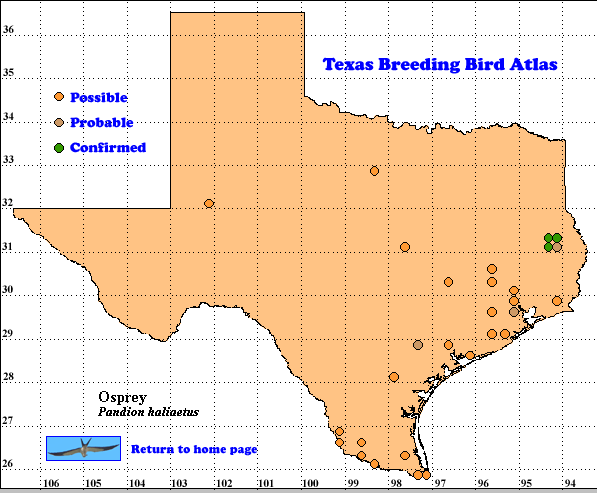Ospreys are conspicuous birds along the shorelines of inland and coastal waters, as they hover over shallow water, watching for fish. After spotting one they plunge feet-first to capture the fish and fly off to eat it. These birds have adapted readily to placing their nests on man-made structures. In some areas most nests are on these objects. Populations have also recovered well from the DDT-induced crash of 1950-1970 (Poole et al. 2002).
The Osprey is considered a single species worldwide (Am. Ornithol. Union 1998) with 4 subspecies: one breeds across Europe and northern Asia, a second in Australia and Indonesia, a resident race in the Caribbean and the mostly migratory North American population (Poole et al. 2002).
DISTRIBUTION. During the 1987-1992 field work seasons of the TBBA project, volunteers found at least 3 confirmed and one probable breeding locations in latilong 31094. Most of the other 2 probable and 28 possible sites were along the coast and on the lower parts of major rivers. In neighboring Oklahoma an active nest was found along the Arkansas River near the eastern edge of that state in 1985 (Stuart 2004).
Elsewhere in North America, breeding occurs from Alaska across Canada to Newfoundland. In the lower 48 states, Ospreys breed through much of the Pacific Northwest, the upper Great Lakes and the Northeast and south along the Atlantic Coast to Florida. Breeding also occurs in northern California and at scattered sites in inland states. In Mexico Ospreys nest along the coasts of Baja California, the opposite shore of the Mexican mainland and the east coast of the Yucatan Peninsula as well as most islands. In winter these birds are found along and near the coasts of the southern United States, Mexico, Central America, the Greater Antilles and locally in northern and central South America (Howell and Webb 1995, Poole et al. 2002).
SEASONAL OCCURRENCE. Ospreys migrate to and through Texas from mid-March to late May and early September to mid-November, when they are uncommon to rare. In winter they are most common along the coast. The rare breedings in Texas probably occur during the long North American season of April through August (Oberholser 1974, Poole et al. 2002, Lockwood and Freeman 2004).
BREEDING HABITAT. Ospreys have two needs for successful breeding: shallow water with fish and a support for their large nest. The water can be a lake, flowing stream, tidal lagoon or ocean. The support can be a live or dead tree, a platform or other man-made structure, or even the ground, on mammal-free islands. The elevational range is wide. Ospreys nest along sea coasts and in conifer forests of interior mountains (Harrison 1979, Barrett 1998, Poole et al. 2002, Driscoll 2005).
The nest, a mass of large and small sticks, often reused in successive years, is lined with inner bark, grass, vines and .a wide variety of human debris. On this platform the female usually lays 3 (range 1-4) creamy white to pinkish cinnamon eggs, wreathed and spotted with reddish brown. These are laid at 2-3 day intervals. The female who does 70% of daylight and all nighttime incubation, starts after laying the first egg. Incubation continues for about 36-42 days (to hatching of the first egg). The young birds take their first flights 50-67 days after hatching and remain with their parents for at least another 10-20 days. Only one brood is raised per year (Harrison 1979, Poole et al. 20020.
STATUS. Osprey is a rare and local breeder in Texas (Lockwood and Freeman 2004). The map in Oberholser (1974) indicate only one breeding site (along the Rio Grande Rover) for Ospreys in this state and only a few scattered summer observations. Lockwood and Freeman (2004) indicate non-breeding individuals are also present in Texas in summer and this probably accounts for some of the possible TBBA observations as well as summer records on Oberholser’s map. While the Breeding Bird Survey data does not produce a population trend for Ospreys in Texas, the annual population change for North America of +5.0% for the period 1980-2006 is statistically significant (Sauer et al. 2007) and suggests a healthy population.
Text by Robert C. Tweit (2007)
Literature cited.
American Ornithologists’ Union. 1998. Checklist of North American birds, 7th ed. Am, Ornithol. Union, Washington, DC.
Barrett, N. M. 1998. Osprey (Pandion haliaetus). In Colorado Breeding Bird Atlas, pp. 104-105 (H. E. Kingery, ed.), Colorado Bird Atlas Partnership, Denver.
Driscoll, J. T. 2005. Osprey (Pandion haliaetus). In Arizona Breeding Bird Atlas. pp. 120-121 (T. E. Corman and C. Wise-Gervais, eds.), University of New Mexico Press, Albuquerque.
Harrison, H. H. 1979. A field guide to western birds’ nests. Houghton Mifflin, Boston, MA.
Howell, S. N. G. and S. Webb. 1995. A guide to the birds of Mexico and northern Central America. Oxford University Press, New York.
Lockwood, M. W. and B. Freeman. 2004. The TOS handbook of Texas birds. Texas A&M University Press, College Station.
Oberholser, H. C. 1974. The bird life of Texas, University of Texas Press, Austin.
Poole, A. F., R. O. Bierregaard and M. S. Martell. 2002. Osprey (Pandion haliaetus). In The Birds of North America, No. 683 (A. Poole and F. Gill, eds.). The Birds of North America, Inc., Philadelphia, PA.
Sauer, J. R., J. E. Hines, and J. Fallon. 2007. The North American Breeding Bird Survey, results and analysis 1966-2006. Version 7.2 2007. USGS Patuxent Wildlife Research Center, Laurel MD < http://www.mbr-pwrc.usgs.gov/bbs>
Stuart, R. A. 2004. Osprey (Pandion haliaetus) In Oklahoma Breeding Bird Atlas, pp. 84-85 (D. L. Reinking, ed.). University of Oklahoma Press, Norman.

